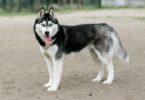Imagine coming home to a fluffy companion whose wagging tail and playful energy instantly lift your mood. For many pet lovers, this joyful scenario becomes reality with a unique hybrid that blends intelligence, charm, and adaptability. Meet the crossbreed stealing hearts nationwide—a perfect fusion of two beloved breeds.
This guide explores everything you need to know about these affectionate companions. Combining the loyalty of a herding breed with the hypoallergenic coat of a water retriever, they thrive in both active households and cozy apartments. Their manageable size and trainable nature make them ideal for first-time owners and seasoned pet parents alike.
You’ll discover how their spirited personality shines during playtime yet mellows into calm cuddles by evening. We’ll break down their grooming needs, health considerations, and strategies for harnessing their natural intelligence through positive reinforcement. Whether you’re exploring best Poodle mixes or seeking a family-friendly companion, this resource prepares you for every wag, bark, and adventure.
From farm-friendly energy to city-smart adaptability, these dogs prove that the best traits often come in small packages. Let’s dive into what makes this crossbreed a standout choice for modern pet lovers.
Introduction to the Corgi Poodle Mix
Meet the crossbreed that’s redefining what it means to be the perfect family pet. Combining the alertness of herding breeds with the problem-solving skills of water retrievers, this hybrid offers a delightful balance of energy and affection. Their compact size and adaptable nature make them ideal for diverse lifestyles.
Why This Crossbreed Steals Hearts
Loyalty meets brains in these charismatic companions. The Welsh Corgi contributes spirited enthusiasm, while the Poodle adds keen intelligence and a low-shedding coat. Families adore their ability to switch from backyard playfulness to calm lap time effortlessly.
An Overview of the Ultimate Guide
This resource dives into everything from the Pembroke Welsh Corgi’s historical roots to modern care strategies. You’ll discover grooming techniques for curly coats, training methods that harness natural intelligence, and health insights for long-term wellbeing. Whether you’re new to designer dogs or seeking breed-specific tips, we cover practical advice for nurturing a happy, thriving companion.
Origins and History of Corgis and Poodles
Centuries of selective breeding and cultural evolution shaped two remarkable canine lineages. Their combined legacy creates a hybrid with intelligence and versatility, but understanding their roots reveals why this pairing works so well.
The Heritage of the Welsh Corgi
Flemish weavers brought herding dogs to Wales in the 10th century. These agile canines evolved into the Pembroke Welsh breed, known for managing cattle with low-to-the-ground efficiency. British royalty later popularized them—Queen Elizabeth II famously kept over 30 during her reign.
Their sharp instincts and compact size made them ideal farm helpers. Unlike larger herders, they nipped at livestock heels while avoiding kicks. This purposeful breeding emphasized loyalty and problem-solving skills still evident in modern crosses.
The Legacy of the Poodle
Originally bred as German water retrievers, Poodles transitioned to French aristocracy by the 15th century. Their curly, hypoallergenic coats protected them in cold waters during duck hunts. Over time, their intelligence made them circus performers and companions.
Breeders prioritized trainability and adaptability. This focus produced dogs excelling in diverse roles—from wartime messengers to therapy animals. Today’s mixes inherit these traits, blending utility with affectionate temperaments.
Responsible breeders pair Pembroke Welsh parents with carefully chosen Poodles to optimize health and personality. For more insights on raising these hybrids, explore our complete guide to Corgipoo care.
Physical Appearance and Size Variations
When choosing a hybrid companion, visual traits often influence decisions as much as personality. These crossbreeds display striking diversity in their coats and builds, blending characteristics from both parent breeds.
Coat Types, Colors, and Patterns
Their fur varies from thick double coats to soft curls. Some inherit the water-resistant undercoat common in herding breeds, while others showcase the Poodle’s hypoallergenic ringlets. Wavy textures frequently emerge as a middle ground.
Color combinations span classic black, cream, and sable to rare merle or phantom patterns. Bicolor pairings like red-and-white dominate, though tricolor mixes with tan points add extra flair. Seasonal shedding depends on coat type—curly varieties often shed less.
Body Structure and Size Considerations
Most inherit short legs and elongated torsos, standing 10-12 inches tall at the shoulder. Weight typically ranges between 20-30 pounds, influenced by the Poodle parent’s size (toy vs miniature). Sturdier builds suit active play, while leaner frames adapt well to apartment living.
Paw shape often mirrors the Corgi’s oval structure, providing stability during quick turns. Ear styles vary—some have erect ears, others floppy. These physical traits combine to create a compact yet athletic appearance perfect for diverse lifestyles.
Temperament and Personality Traits
A dog’s personality shapes every aspect of home life, from morning routines to evening snuggles. This crossbreed excels at balancing spirited play with devoted companionship, making them particularly appealing to households seeking versatile pets.
Family-Oriented and Loyal
These hybrids form deep bonds with their human families. Their watchful nature stems from herding instincts, yet they remain gentle around younger members. Many owners report their dogs instinctively position themselves between children and perceived dangers during outdoor adventures.
Loyalty manifests through constant companionship. They’ll follow you from room to room, content simply being near their favorite people. This trait makes them excellent emotional support animals for families dealing with stress or life changes.
Playfulness and Intelligence
Puppies showcase remarkable problem-solving skills from early ages. One owner described their pet mastering puzzle toys faster than any previous breed. This intelligence pairs with endless curiosity—they thrive when given new challenges during training sessions.
Playfulness adapts beautifully to different settings. These dogs might chase balls enthusiastically at parks, then switch to quiet indoor games when weather keeps families inside. Their energy levels typically match their household’s rhythm, making transitions between activities seamless.
Health and Lifespan of the Corgi Poodle Mix
A dog’s health journey requires proactive care and informed decisions. Crossbreeds often benefit from hybrid vigor, reducing risks linked to purebred genetic issues. While generally robust, these companions still need tailored attention to thrive.
Common Health Concerns
Joint issues like hip dysplasia occasionally surface due to their body structure. Eye conditions and allergies may also occur, though less frequently than in purebred parents. Weight management proves critical—their love for food demands measured portions to avoid obesity-related problems.
Dental health remains a priority. Regular brushing prevents plaque buildup, and vet-recommended chews support gum strength. Annual checkups catch early signs of heart or thyroid concerns, ensuring swift treatment if needed.
Lifespan Expectations
With proper care, these dogs typically live 12-15 years. Their lifespan mirrors both parent breeds, benefiting from genetic diversity. Preventive measures like vaccinations and parasite control add healthy years to their lives.
Genetic testing helps breeders screen for hereditary conditions. Partnering with a trusted vet creates a care plan addressing breed-specific needs. Routine bloodwork and dental cleanings further safeguard their long-term well-being.
Grooming and Maintenance Requirements
Maintaining your hybrid companion’s coat requires strategic care tailored to their unique genetics. While purebred herding dogs often shed heavily, this crossbreed typically inherits a low-shedding coat from their water-retriever lineage. Weekly routines prove simpler than many expect—ideal for busy households wanting minimal mess.
Daily Brushing and Bathing Tips
Curly or wavy coats benefit most from quick daily brushing. Use a slicker brush to prevent mats, focusing on areas behind ears and under legs. Short-haired varieties need less frequent care—a rubber grooming mitt twice weekly removes loose hairs effectively.
Bathing every 4-6 weeks keeps their skin healthy. Choose oatmeal-based shampoos for sensitive skin, common in Poodle-dominant coats. Professional groomers recommend trimming paw fur monthly to prevent debris buildup during walks.
Experienced owners suggest observing which parent’s coat traits dominate. Those with tighter curls require conditioner to maintain softness, while straighter fur needs occasional de-shedding tools. Always dry thoroughly after baths to avoid skin irritation.
This adaptable approach reduces salon visits. A quick wipe-down with grooming wipes between baths keeps them fresh. Regular nail trims and ear checks complete a balanced care routine for this lively companion.
Diet, Exercise, and Feeding Tips
Proper nutrition and activity form the foundation of a thriving canine companion. This crossbreed’s metabolism thrives on balanced meals paired with strategic movement. Tailoring their routine prevents weight issues while supporting their spirited nature.
Recommended Dog Food and Nutrition
High-quality proteins like chicken or salmon fuel their energy. Brands like Purina Pro Plan offer formulas with omega fatty acids for coat health. Measure portions carefully—¾ to 1½ cups daily split into two meals works for most adults.
Avoid free-feeding to prevent obesity. Treats shouldn’t exceed 10% of daily calories. Look for foods listing whole ingredients first, avoiding fillers like corn syrup. Consult your vet to adjust portions based on age and activity spikes.
Exercise Routines and Activity Levels
Daily 30-minute walks plus play sessions maintain muscle tone. Interactive toys challenge their problem-solving skills indoors. Fetch games in fenced areas provide safe bursts of exercise.
Monitor breathing during summer activities—their compact build can overheat. Puzzle feeders combine mealtime with mental stimulation. Consistent routines prevent destructive behaviors from pent-up energy.
Pairing nutrient-rich food with structured movement creates lasting vitality. Annual vet checkups fine-tune dietary needs as your companion ages. This balance ensures they remain agile companions for years.
Training and Socialization Guidelines
Building a strong bond with your companion starts with structured guidance and consistent routines. Intelligent hybrids thrive when mental stimulation meets clear expectations, creating harmony between energetic play and household rules.
Positive Reinforcement Techniques
Treat-based rewards work wonders for shaping desired behaviors. Experts recommend clicker training paired with high-value snacks like freeze-dried liver. Immediate praise after commands like “sit” or “stay” reinforces quick learning.
Address stubbornness by breaking tasks into smaller steps. If leash pulling occurs, stop walking until tension eases. Consistency across all family members prevents confusion—establish unified commands and reward systems.
Early Socialization Strategies
Puppy classes between 8-16 weeks lay critical foundations for confidence. Exposure to diverse sounds, surfaces, and friendly strangers reduces anxiety in new environments. Pair these experiences with calm reassurance to build trust.
Incorporate expert puppy training advice into daily interactions. Practice “meet-and-greet” sessions with vaccinated dogs at local parks. Rotate toys during playdates to encourage sharing and prevent resource guarding.
Owners should lead training sessions personally to strengthen their role as pack leaders. Ten-minute daily drills maintain skills without overwhelming young learners. Celebrate progress with favorite activities like fetch or belly rubs.
Living Environments and Adaptability
What makes a home ideal for these energetic companions? Their remarkable flexibility allows them to thrive in diverse settings, from studio apartments to sprawling suburban yards. Owners consistently report their ability to adjust routines based on available space while maintaining cheerful dispositions.
Space Needs and Social Connections
Urban dwellers appreciate how compact bodies fit perfectly in tight living quarters. A New York City owner shares how their dog navigates 600 square feet effortlessly: “Short legs don’t limit her—she zooms around furniture like a pro racer.” Daily walks and weekend park visits fulfill exercise needs despite limited indoor space.
Suburban homes benefit from secure yards for off-leash play. However, their people-oriented nature means they prefer family interaction over solo outdoor time. One Texas family notes: “He’ll bark at squirrels for 10 minutes, then sprint back to join us on the porch.”
Regardless of home size, structured outdoor activities prevent boredom. Interactive games like scent trails or agility courses channel energy constructively. Always use leashes in unsecured areas—their curiosity can override recall training when chasing butterflies.
These adaptable companions prove environment matters less than consistent engagement. Whether in high-rises or ranch houses, they flourish when surrounded by loving people and stimulating routines.
Understanding the corgi poodle mix: Traits You’ll Love
What makes a crossbreed truly stand out in a crowded pet market? This hybrid combines sharp problem-solving skills inherited from water retrievers with unwavering devotion rooted in herding breeds. Their balanced nature makes them equally suited for adventurous hikes and cozy movie nights.
Puppies often display bursts of curiosity that evolve into focused intelligence as adults. Owners report their pets mastering commands like “quiet” and “leave it” by six months. This quick learning pairs with a loyal streak—they’ll shadow family members while keeping watch over their domain.
Adult dogs typically weigh 20-30 pounds, fitting comfortably in small homes or apartments. Their compact frame requires less space than larger breeds but still packs energy for playtime. Regular walks and puzzle toys keep both body and mind engaged through adulthood.
Families appreciate how manageable size meets big personality. A sturdy build handles roughhousing with kids, while gentle manners shine during calm moments. First-time owners find their adaptability reduces stress—they thrive on routine yet adjust to schedule changes gracefully.
From corgipoo puppy antics to mature companionship, these dogs offer lasting appeal. Their blend of smarts, loyalty, and practicality creates a four-legged friend that enhances any household dynamic.
Breeding, Genetics, and Designer Dog Insights
What separates a well-bred designer dog from an impulsive backyard creation? Responsible breeding combines science, ethics, and patience to produce healthy mixed breeds. By merging the Welsh herding lineage with water-retrieving intelligence, this hybrid gains hybrid vigor—reducing inherited health issues common in purebreds.
Genetic Testing and Health Screening
Ethical breeders prioritize DNA tests for both parent breeds. These screenings check for conditions like degenerative myelopathy and eye disorders. Results guide pairings to minimize risks, ensuring puppies start life with strong genetic foundations.
Reputable programs follow strict timelines. They wait until parent dogs pass health clearances at 2 years old before breeding. Puppies receive early neurological exams and temperament assessments to match them with suitable homes.
Choosing healthy parents impacts generations. Breeders who track lineage through pedigree databases reduce unpredictable traits. They also socialize litters during critical developmental windows—weeks 3 to 14—to build confidence.
Designer dogs demand commitment beyond profit. Trusted breeders offer lifetime support and take-back guarantees. They prioritize transparency, sharing vet records and genetic reports to empower informed adoptions.
Final Considerations for Your New Furry Family Member
Welcoming a hybrid breed into your life promises years of joy paired with specific care requirements. This adaptable companion thrives in diverse homes, blending spirited play with calm companionship. Their manageable size and moderate exercise needs suit both busy professionals and active families.
Prospective owners should prioritize early socialization and consistent training. Stock up on puzzle toys, grooming tools, and high-quality food before bringing your puppy home. Regular vet checkups and portion-controlled meals help maintain their energetic personality.
The balance of intelligence, loyalty, and low-maintenance grooming makes this crossbreed ideal for first-time pet parents. While their herding instincts demand engagement, they adapt well to relaxed evenings after outdoor adventures.
Remember: adopting any dog requires a decade-long commitment to their wellbeing. The Corgi Poodle mix rewards dedicated owners with unwavering affection and daily laughter. For personalized advice on raising your new companion, connect with breed communities or consult trusted veterinarians.
FAQ
What’s the average lifespan of a Pembroke Welsh Corgi and Poodle crossbreed?
These hybrids typically live 12–15 years with proper care. Regular vet checkups and a balanced diet help address potential genetic issues inherited from parent breeds.
Do these mixed breeds require special grooming for their coat types?
Yes, their wavy or curly fur often needs daily brushing to prevent matting. Monthly trims and occasional baths maintain cleanliness, especially if they inherit the Poodle’s hypoallergenic traits.
How much daily exercise does a high-energy cross like this need?
Aim for 45–60 minutes of activity, like walks or interactive play. Their herding instincts from the Pembroke Welsh lineage may demand mentally stimulating tasks to curb boredom.
Are these dogs suitable for families with young children?
Their loyal and playful nature makes them great companions for older kids. Supervision is advised around toddlers due to the breed’s short legs and potential herding behaviors.










Leave a Comment